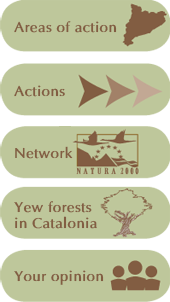Action D1. Monitoring and evaluation of conservation actions
The purpose of this action is to evaluate the effectiveness of conservation actions by monitoring biological variables, before and after the habitat improvement treatments. You can download the report of ecological monitoring results by clicking here.
Paper on Forest structure of Mediterranean yew groves (Life TAXUS)
Objectives
This action is based on evaluating the effectiveness of conservation actions by means of monitoring biological variables before and after treatments to improve the habitat.
Methodology
Action C1. Forestry activities to regulate competition
Selection of yew adults and seedlings with two thinning intensities. Measures:
•Apical growth and growth of three side yew shoots.
•Increase in diameter of the yew.
•C isotopic ratio in leaves (indicator of stress).
•Wooded cover (hemispheric photo).
•Diameters and regenerated woody species in 1 m radius (seedlings) and 5 m radius (adults).
Frequency: one inventory / year (autumn-winter 2013 to summer-autumn 2016).
Indicators: radial growth (mm / year) and height of yew (mm / year); lighting / understory cover (%); water stress.
|
Scenario
|
samples
|
|
Partial thinning of crown. Apical and lateral competition. Trees from 2.5 to 7.5 cm dbh.
|
20
|
|
Completely open canopies. It also shows part of the border that intercepts light. Trees from 7.5 to 12.5 cm dbh.
|
20
|
|
Without treatment on the yews (control)
|
20
|
|
Scenario
|
samples
|
|
Clearing shrubs and lianas 1 m around the yew stem. It leaves a protective shrub trimming around the perimeter.
|
20
|
|
Untreated (control)
|
20
|
Action C2. Phytosanitary treatments to reduce the incidence of the Armillaria fungus on the yews
Measurement of base growth in diameter affected by Armillaria (by dendrometres); increase in diameter, height and number of shoots affected before and after treatment.
Frequency of monitoring: a sampling / year (autumn-winter 2013 to summer-autumn 2016).
Indicators: number of infected trees, radial growth of shoots (mm / year) of infected trees treated and untreated (control), number of new infections per sampling plot.
Action C3. Herbivorous exclusion actions
We have defined 20 plots (4-m2) around young yews control plots and six with the herbivore exclusion closure. Each plot is marked by young yew up to 130 cm, with survival and apical height recorded.
In the control plots we estimated the number of sprout outbreaks and assessed the degree of attachment by the survival of individuals and regenerated.
Frequency of monitoring: once at year
Indicators: number of apical shoots in young yews growing inside and outside the closure of herbivore exclusion; degree of attachment to regenerate the plot; apical growth (mm / year).
Follow up for actions C4, C5 and C6. Obtaining and monitoring seedling plantations.
- Degree of viability of seeds (Tetrazoli method) in two fruit collecting harvests (2012, 2013).
- Percentage of germination (C4), and number of seedling survival in the nursery (C5).
- Survival of seedlings planted on the field (C6) depending on the location: substrate and hedge species tutor.
- Frequency of monitoring: a count once the germination is completed, sampling to estimate seedling survival following the dry season after planting (October 2015 and 2016).
Indicators: Potential viability of seeds, percentage of germinated seeds per tray nursery; survival on the field according to placement and location.
Action C7. Promotion of frugivorous bird populations
Each parcel will be tracked for their frequency of dispersers (frugivorous birds and mammals) by means of point counts for bird monitoring and camera trap for birds and mammals before and after actions.
Frequency of monitoring: two samplings in autumn before and after treatments.
Indicators: number of dispersers by species before and after treatment; behaviour patterns.
Action C8. Forestry activities against wildfires
Vegetation transects are conducted to quantify the mass of fuel before treatment and its evolution after the management. To measure the height and cover of shrubs and lianas.
To evaluate the effect of the action on biodiversity, using birds as indicators. On selected plots, to perform a census of birds transect before and after treatment and control transects.
Frequency of monitoring: an inventory of vegetation and bird census before and after treatment (spring).
Indicators: volume of fuel, height and cover of vegetation under tree canopies. Evolution of the main tree and shrub species (mm / year).
Action C9. Stabilization of slopes
We tracked the evolution of erosion in the foundation of yews in nearby areas and distal barriers against erosion by means of visual inspection and quantification of damages in vegetation cover before and after the installation of the defences.
Frequency of monitoring: a visit every six months to detect damage (March 2013 – November 2016) and an inventory of vegetation cover / year (summer 2013 – summer 2016).
Indicators: erosion near the bases of the yews with respect to defences located at greater distances, increased vegetation cover in the sampling plots.
Action C10. Recovery of grazing areas to reduce livestock loads
Grass production in plots reclaimed by mowing before the entry of cattle. Estimates of the time of year for livestock stocking; vegetation inventory at the beginning and end of the action.
Frequency of monitoring: a visit before the entry of cattle annually.
Indicators: forage available (g MS/m2); livestock loads (UBM / month); evolution of grazing (% coverage of main plant species).

